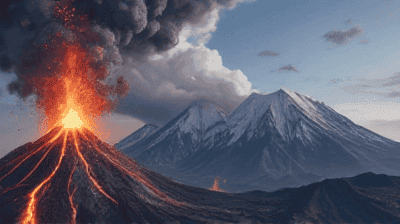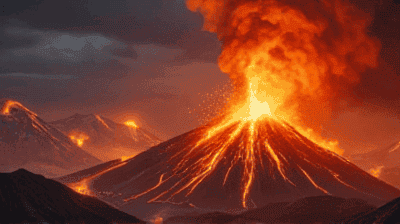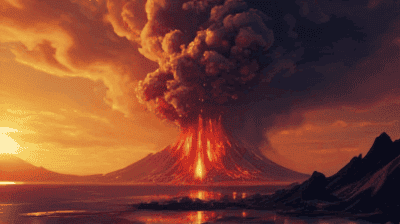Volcanic Eruptions: What Causes Them and Can We Predict Them?
Volcanic eruptions are some of the most powerful and dramatic natural phenomena on Earth. From the fiery lava flows of Kilauea in Hawaii to the cataclysmic explosions of Mount Vesuvius in Italy, these eruptions can reshape landscapes, affect ecosystems, and pose significant risks to human life. Understanding the causes of volcanic eruptions and the potential for predicting them is crucial for ensuring safety and minimizing the impacts on communities living near active volcanoes.

What is a Volcano?
A volcano is an opening in the Earth's crust through which molten rock, gases, and ash escape to the surface. The material that erupts can come from deep within the Earth, offering a glimpse into the processes occurring in the planet's interior. Volcanic eruptions can take many forms, ranging from gentle lava flows to explosive ash clouds, depending on the type of volcano and the composition of the erupting material.
Types of Volcanoes
Understanding the different types of volcanoes helps clarify how eruptions occur and the characteristics of different volcanic systems:
Shield Volcanoes: These are gently sloping mountains formed by the eruption of low-viscosity basalt lava. The lava flows easily, creating broad, shield-like shapes. An example is Mauna Loa in Hawaii.
Stratovolcanoes: Also known as composite volcanoes, these are characterized by steep profiles and eruptions of more viscous lava, often leading to explosive activity. Mount St Helens and Mount Fuji are notable examples.
Cinder Cone Volcanoes: These smaller, steep-sided volcanoes are built from the accumulation of volcanic debris, such as ash and cinders. They usually have single eruptions and can be found in areas like the San Francisco Volcanic Field in Arizona.
Lava Domes: Formed by the slow accumulation of viscous lava, lava domes are typically dome-shaped and can be quite dangerous due to their potential for explosive eruptions.
The Science Behind Volcanic Eruptions

To understand volcanic eruptions, we must delve into the geology and processes that lead to their occurrence. The Earth's interior is composed of layers, each with different temperatures, pressures, and compositions.
1. The Earth's Structure
The Earth consists of several layers, each playing a crucial role in volcanic activity:
Crust: The outermost layer of the Earth, where volcanoes are located.
Mantle: The layer beneath the crust, composed primarily of silicate rocks. The upper mantle is partially molten, allowing for the movement of magma.
Core: The innermost layer, composed of iron and nickel, generates heat that drives geological processes in the mantle and crust.
2. Magma Formation
Magma is molten rock that forms beneath the Earth's surface. Several factors contribute to the formation of magma:
Temperature: When rocks in the mantle are subjected to high temperatures, they can melt to form magma.
Pressure: Increased pressure can keep rocks solid, but when tectonic activity lowers the pressure, melting can occur.
Water Content: Water lowers the melting point of rocks, allowing them to melt more easily. The presence of water is particularly significant in subduction zones.
3. Types of Magma
The composition of magma varies, influencing the type of eruption that will occur:
Basaltic Magma: Low in viscosity, allowing gases to escape easily. This type leads to gentle eruptions and is common in shield volcanoes.
Andesitic Magma: Intermediate viscosity and gas content, leading to more explosive eruptions. Found in stratovolcanoes.
Rhyolitic Magma: High in viscosity, traps gases, and can result in highly explosive eruptions. Typically found in caldera-forming eruptions.
Triggers of Volcanic Eruptions
Volcanic eruptions are triggered by various geological processes, often related to the movement of magma beneath the Earth's surface. Understanding these triggers is essential for predicting eruptions.
1. Pressure Buildup
As magma rises toward the surface, it can accumulate in a chamber within the crust. The pressure within this magma chamber rises as more magma enters the chamber, leading to potential eruptions when the pressure exceeds the strength of the rocks above.
- Gas Expansion: Dissolved gases in magma, such as water vapor, carbon dioxide, and sulfur dioxide, can expand as pressure decreases during ascent. This expansion increases the pressure within the magma and can lead to explosive eruptions.
2. Tectonic Activity
The movement of tectonic plates plays a significant role in volcanic eruptions. Many volcanoes are found at plate boundaries due to the interactions between plates:
Subduction Zones: At convergent boundaries, an oceanic plate sinks beneath a continental plate, leading to the formation of magma through melting. This process results in volcanic arcs, such as the Andes Mountains.
Rift Zones: At divergent boundaries, tectonic plates move apart, allowing magma to rise and create new crust. This is seen in places like the Mid-Atlantic Ridge.
Hotspots: Some volcanic activity occurs away from plate boundaries. Hotspots are areas where plumes of hot mantle material rise to create volcanoes, such as the Hawaiian Islands.
Predicting Volcanic Eruptions

One of the most crucial aspects of volcanology is the ability to predict eruptions. While forecasting earthquakes remains challenging, scientists have developed methods to monitor volcanic activity and assess the likelihood of eruptions.
1. Volcanic Monitoring Techniques
Several techniques are employed to monitor volcanoes and detect signs of potential eruptions:
Seismology: The use of seismographs to detect volcanic tremors and earthquakes is crucial for understanding magma movement. Increased seismic activity often indicates that magma is moving toward the surface.
Gas Emissions: Analyzing gases released from a volcano can provide insights into its state. Changes in the composition or rate of gas emissions may signal an impending eruption.
Ground Deformation: The use of GPS and InSAR (Interferometric Synthetic Aperture Radar) allows scientists to measure ground deformation caused by the accumulation of magma beneath the surface. Inflation of the volcano is often a precursor to an eruption.
Temperature Measurements: Remote sensing and thermal imaging can help detect changes in temperature around a volcano. Increased temperatures may indicate rising magma.
2. Historical Eruption Patterns
Studying the history of a volcano’s eruptions can aid in predicting future activity. Volcanologists look for patterns in past eruptions, such as the frequency, size, and types of eruptions. Understanding these patterns can provide valuable information about a volcano's potential behavior.
3. Challenges in Prediction
Despite advancements in monitoring techniques, predicting the exact timing and nature of volcanic eruptions remains challenging. Some of the factors contributing to the difficulty of prediction include:
Complexity of Magma Systems: The behavior of magma systems is complex and not fully understood. Variability in the composition and behavior of magma can lead to unexpected eruption styles.
Lack of Warning Signs: Not all volcanic eruptions produce clear warning signs. Some eruptions occur with little or no seismic activity, making them difficult to anticipate.
Human and Geological Factors: The presence of population centers near volcanoes adds complexity to prediction efforts, as scientists must also consider social and economic factors when assessing risks.
Case Studies: Notable Volcanic Eruptions
To illustrate the complexities of volcanic eruptions and their impacts, we can examine several notable case studies.
1. Mount St Helens, USA (1980)
Mount St Helens is one of the most studied and documented volcanic eruptions in history. The volcano had been relatively quiet since 1857, but signs of unrest began in early 1980.
Eruption Details: The eruption began on May 18, 1980, with a massive explosion that resulted in the collapse of the northern flank of the volcano. The initial blast was followed by volcanic ash and pyroclastic flows.
Impact: The eruption caused significant destruction, including the loss of 57 lives and the devastation of thousands of acres of forest. The recovery and ecological succession in the area have been the subject of extensive research.
Lessons Learned: The monitoring efforts leading up to the eruption underscored the importance of communication between scientists and the public, leading to improved practices in risk assessment.
2. Mount Vesuvius, Italy (79 AD)
The eruption of Mount Vesuvius in 79 AD is one of the most famous volcanic events in history, known for the destruction of the Roman cities of Pompeii and Herculaneum.
Eruption Details: This eruption was characterized by Plinian ash clouds that rose high into the atmosphere, followed by pyroclastic flows and the deposition of volcanic ash. The cities were buried under meters of ash, preserving them for centuries.
Impact: The expertly preserved ruins provide insights into Roman life and culture. The eruption serves as a reminder of the destructive potential of volcanoes and the need for continual monitoring.
Lessons Learned: Today, the area around Vesuvius remains densely populated, and researchers continue to study the volcano to understand its risks better.
3. Kilauea, Hawaii
Kilauea volcano is one of the most active volcanoes in the world, with continuous eruptions since the 1980s. Its eruptions are closely monitored, providing valuable data on volcanic activity.
Eruption Details: Kilauea is characterized by its relatively gentle eruptions, primarily producing basaltic lava flows. The 2018 eruption was particularly notable for its extensive lava flows that destroyed hundreds of structures.
Impact: The eruptions have reshaped the local landscape and affected ecosystems, while also highlighting the importance of community preparedness and response.
Lessons Learned: The long-term monitoring of Kilauea has provided a wealth of scientific knowledge, demonstrating the importance of real-time data collection and public awareness about volcanic hazards.
Conclusion

Volcanic eruptions are complex phenomena shaped by various geological processes. Understanding what causes these eruptions and how we can predict them is vital for ensuring the safety of communities living near active volcanoes. While significant advancements have been made in monitoring and predicting volcanic activity, challenges remain. Continued research and technological advances will enhance our ability to forecast eruptions and mitigate their impacts. As we better understand these powerful natural events, we can improve safety measures and prepare for the challenges posed by living in the shadow of volcanoes.
